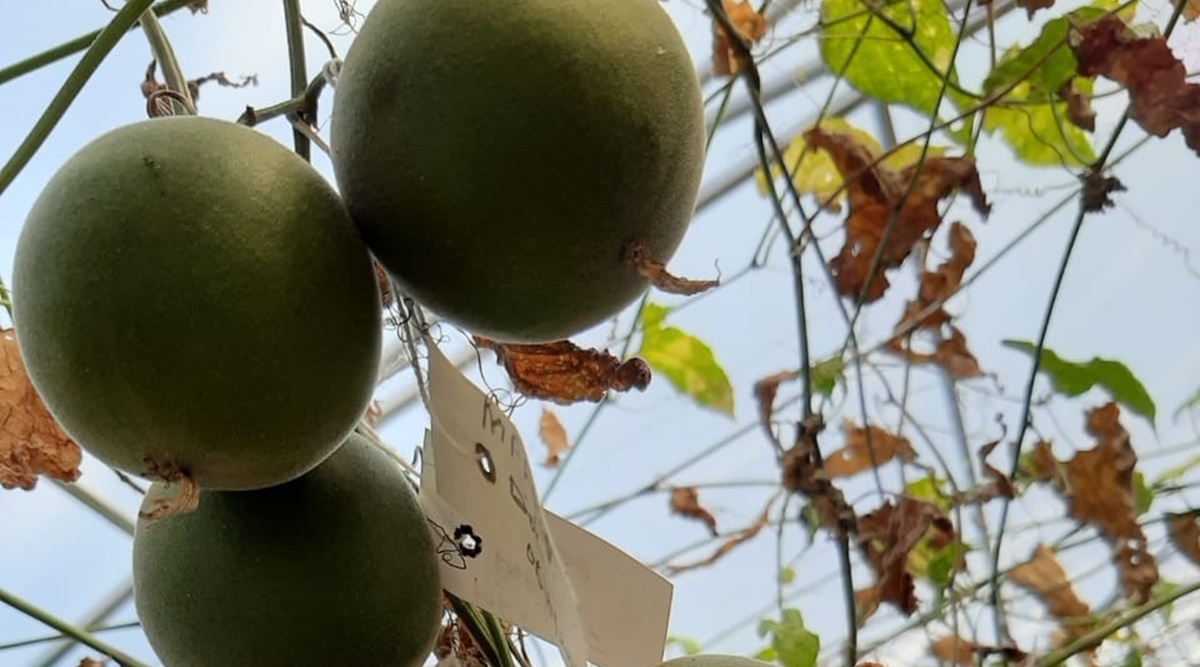 This, as per CSIR-IHBT, is the first ever monk fruit cultivation exercise in India.
This, as per CSIR-IHBT, is the first ever monk fruit cultivation exercise in India. The ‘monk fruit’ from China, which is known for its properties as non-caloric natural sweetener, was Monday introduced for field trials in Himachal Pradesh by the Palampur-based Council of Scientific Research and Industrial Technology-Institute of Himalayan Bio-resource Technology (CSIR-IHBT) in Kullu.
The field trials have begun three years after the CSIR-IHBT imported its seeds from China and grew it in the house.
Fifty seedlings were planted in the fields of progressive farmer Manav Khullar from Raison village for field trials and CSIR-IHBT signed a ‘Material Transfer Agreement’ with Manav. The economic benefits of the new crop are estimated to be between Rs 3 lakh to Rs 3.5 lakh per hectare.
This, as per CSIR-IHBT, is the first ever monk fruit cultivation exercise in India.
As per CSIR-IHBT Principal Scientist Dr Probir Kumar Pal, the Monk fruit is “a perennial crop having a life span ranging between four to five years and its fruiting starts eight to nine months after germination”.
As per Dr Pal, “The flowering pattern, pollination behaviour and fruit setting time were also documented to draw a complete life-cycle of monk fruit in Palampur agro-climatic conditions.”
“The plant prefers mountainous area with an annual mean temperature of about 16–20 °C and humid conditions,” said Dr Pal. Monk Fruit gets its name from the Buddhist monks who first used it. During the 20th century, Professor G W Groff had made an attempt to grow Monk plant. However, the attempt was unsuccessful as flowers did not appear.
Agro-tech developed by CSIR-IHBT
Seed germination rate is of monk fruit is slow and low, thus seed germination technique has been developed to increase the germination rate and reduce the germination time.
The institute has developed planting method and standardised planting time. It has also developed a method for generation of characterised planting material, and standardised the harvesting time for getting higher Mogroside-V content in fruit. Post-harvest management practices have also been developed.
Nature’s sweet superfood: The monk fruit
The monk fruit (siraitia grosvenorii), is known now throughout the world for its intensely sweet taste, and it has been used as a non-caloric natural sweetener. The sweet taste of monk fruit results primarily from the content of a group of cucurbitane-type triterpene glycosides known as mogrosides, and the extracted mixture of mogrosides is about 300 times sweeter than sucrose or cane sugar. The purified mogroside, has been approved as a high-intensity sweetening agent in Japan and the non-caloric sweet taste extract is a generally recognized as safe (GRAS) non-nutritive sweetener, flavour enhancer, and food ingredient in the USA.
The demand for monk fruit is gradually increasing in the international market. In spite of high demand, this crop is cultivated only in China. However, suitable agroclimatic conditions are available in India, particularly in Himachal Pradesh.
As per a note by CSIR-IHBT “Intake of added cane sugars can lead to life-threatening diseases such as insulin resistance, Type 2 diabetes, liver problems, metabolic syndrome, heart disease, etc. As per the world health organization (WHO) report, worldwide 346 million people are diabetic. Several synthetic sweeteners of low calorific value have recently been appeared in the pharmaceutical and food industries, but their health hazards due to harmful side effects restrict their utility. Thus, the production of sugar substitutes, particularly non-nutritive natural sweeteners, is a major challenge for scientists.”
- The Indian Express website has been rated GREEN for its credibility and trustworthiness by Newsguard, a global service that rates news sources for their journalistic standards.

